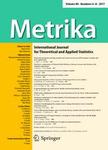版权所有:内蒙古大学图书馆 技术提供:维普资讯• 智图
内蒙古自治区呼和浩特市赛罕区大学西街235号 邮编: 010021

作者机构:McMaster Univ Dept Math & Stat Hamilton ON L8S 4K1 Canada
出 版 物:《METRIKA》 (Metrika)
年 卷 期:2009年第69卷第2-3期
页 面:351-396页
核心收录:
学科分类:0202[经济学-应用经济学] 02[经济学] 020208[经济学-统计学] 07[理学] 0714[理学-统计学(可授理学、经济学学位)]
主 题:Step-stress models Type-I censoring Type-II censoring Progressive censoring Hybrid censoring Exponential distribution Accelerated life-test Cumulative exposure model Maximum likelihood estimation Conditional moment generating function Conditional inference Stochastic monotonicity Fisher information Bootstrap method Coverage probabilities Optimal step-stress change Gamma distribution Truncated binomial distribution Truncated trinomial distribution Truncated multinomial distribution Truncated exponential distribution Mixture distribution Order statistics Bias Mean square error Competing risks
摘 要:A reliability experimenter is often interested in studying the effects of extreme or varying stress factors such as load, pressure, temperature and voltage on the lifetimes of experimental units. Accelerated life-tests allow the experimenter to vary the levels of these stress factors in order to obtain information on the parameters of the lifetime distributions more rapidly than under normal operating conditions. Step-stress tests are a particular class of accelerated life-tests which allow the experimenter to change the stress levels at pre-fixed times during the life-testing experiment. One of the prominent models assumed in step-stress tests is the cumulative exposure model which connects the lifetime distribution of units at one stress level to the lifetime distributions at preceding stress levels. Under such a cumulative exposure model and the assumption that the lifetimes at different stress levels are exponentially distributed, we review in this article various developments on exact inferential methods for the model parameters based on different forms of censored data. We also describe the approximate confidence intervals based on the asymptotic properties of maximum likelihood estimators as well as the bootstrap confidence intervals, and provide some comparisons between these methods. Finally, we present some examples to illustrate all the inferential methods discussed here.